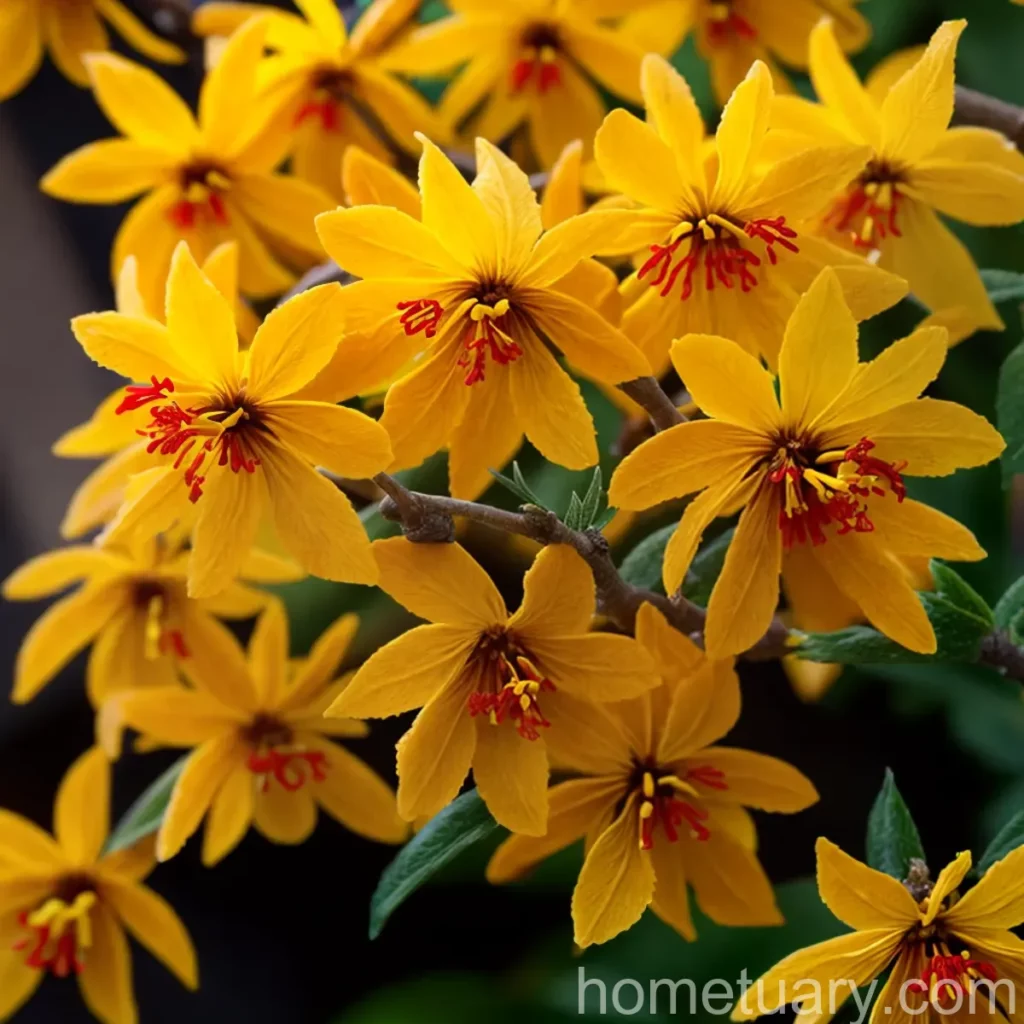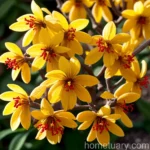Chinese Witch Hazel (Hamamelis mollis ‘Gold Edge’)
Chinese witch hazel (Hamamelis mollis ‘Gold Edge’) is a stunning and versatile plant with attractive foliage and fragrant flowers, making it a popular choice for gardens and landscapes. This plant is prized for its ornamental value and its ability to thrive in a variety of conditions. In this comprehensive guide, we will explore the key aspects of Chinese witch hazel care, including its culture, uses, water requirements, sunlight needs, fertilizer, soil preferences, pruning techniques, propagation methods, and container gardening.
What is Chinese Witch Hazel?
Chinese witch hazel, scientifically known as Hamamelis mollis ‘Gold Edge’, is a deciduous shrub that belongs to the family Hamamelidaceae. Originating from China, this plant is celebrated for its vibrant and showy flowers, which typically bloom in late winter to early spring. The distinctive yellow-gold margined leaves add an extra dimension of visual interest to this cultivar.
Key Takeaways – Chinese Witch Hazel (Hamamelis mollis ‘Gold Edge’)
Before delving into the specifics of caring for Chinese witch hazel, let’s highlight the key takeaways associated with this plant:
- Plant Name: Chinese witch hazel (Hamamelis mollis ‘Gold Edge’)
- Cultivar: ‘Gold Edge’
- Family: Hamamelidaceae
- Origin: China
- Characteristics: Fragrant flowers, yellow-gold margined leaves
- Season of Interest: Late winter to early spring
Now, let’s dive into the various aspects of caring for Chinese witch hazel, from its cultural preferences and uses to maintenance and disease resistance.
Culture
Uses
Chinese witch hazel (Hamamelis mollis ‘Gold Edge’) is valued for a range of landscape and gardening applications. Here are some popular uses of this cultivar:
- Garden Borders: The vibrant foliage and fragrant flowers make it an eye-catching addition to garden borders, where it can enhance visual appeal and create focal points.
- Specimen Plant: Due to its striking appearance, it can be planted as a standalone specimen to showcase its unique features.
- Shrub Borders: This shrub can be incorporated into mixed shrub borders to add diversity and seasonal interest.
- Winter Gardens: Chinese witch hazel’s late winter to early spring blooms provide a welcome burst of color in winter gardens when few other plants are flowering.
- Fragrance Gardens: The sweet fragrance of the flowers makes Chinese witch hazel a desirable addition to fragrance gardens.
Water
Chinese witch hazel thrives in moist but well-draining soil. During the growing season, it is essential to ensure that the plant receives an adequate supply of water. However, it is equally important to avoid waterlogging, as excessive moisture can lead to root rot and other related issues. Once established, the plant exhibits some tolerance to drought conditions.
Sunlight
When it comes to sunlight requirements, Chinese witch hazel prefers a partially shaded to fully sunny location. It can tolerate a range of light conditions, making it adaptable to different garden settings. In hotter climates, providing some afternoon shade can help protect the plant from excessive heat stress.
Fertilizer
In terms of fertilization, Chinese witch hazel benefits from a balanced, slow-release fertilizer. Apply the fertilizer in early spring before new growth emerges. Additionally, a layer of organic mulch around the base of the plant can help retain soil moisture and provide essential nutrients as it decomposes.
Soil
Well-draining, acidic to neutral soil is ideal for Chinese witch hazel. The plant prefers soil with a pH range of 5.5 to 6.5. Furthermore, the soil should be rich in organic matter to promote healthy growth and flowering.
Pruning
Proper pruning is essential for maintaining the shape, health, and vigor of Chinese witch hazel. Pruning should be performed after the plant has finished flowering, typically in late spring or early summer. Here are some key pruning techniques for Chinese witch hazel:
- Remove Dead or Diseased Wood: Trim away any dead or diseased wood to promote overall plant health.
- Thinning: Thin out older branches as needed to encourage airflow and light penetration within the plant canopy.
- Shaping: Prune to maintain the desired shape and size of the plant.
Propagation
Chinese witch hazel can be propagated through various methods, including:
- Softwood Cuttings: Softwood cuttings can be taken in early summer and rooted in a moist, well-draining medium.
- Layering: Air layering or ground layering are effective propagation techniques for Chinese witch hazel.
- Grafting: Grafting onto compatible rootstock can also be employed to propagate specific cultivars.
Container Popularity
Due to its manageable size and ornamental value, Chinese witch hazel is well-suited for container gardening. It can thrive in large containers on patios, decks, or balconies, providing a stunning display of flowers and foliage. When growing Chinese witch hazel in containers, be sure to use a well-draining potting mix and monitor watering needs more closely, as the soil in containers tends to dry out faster than garden soil.
Container Common Diseases
When growing Chinese witch hazel in containers, it’s important to be mindful of potential diseases that may affect the plant. Common diseases that can impact Chinese witch hazel in container settings include:
- Root Rot: Overwatering or poorly-draining soil in containers can lead to root rot, which can affect the plant’s overall health.
- Powdery Mildew: Under crowded or poorly ventilated conditions, powdery mildew can develop on the foliage, impacting the plant’s aesthetics.
It’s essential to provide proper air circulation, maintain appropriate watering practices, and monitor the overall health of Chinese witch hazel when grown in containers to prevent these diseases.
Botanist’s Tips
As a plant scientist, I often encounter questions about Chinese witch hazel care and cultivation. Here are some valuable tips based on my expertise:
- Mulching: Utilize organic mulch around the base of the plant to conserve moisture, insulate the roots, and provide essential nutrients.
- Pruning Caution: Exercise caution when pruning, as Chinese witch hazel sets its flower buds in summer. Improper pruning can inadvertently remove next year’s flower buds.
- Fertilization: Use a balanced fertilizer with an emphasis on phosphorus to promote healthy root development and abundant flowering.
Fun Facts
Let’s explore some intriguing facts about Chinese witch hazel:
- The fragrant flowers of Chinese witch hazel are often used to produce perfumes and fragrances due to their rich and alluring scent.
- This cultivar is known for its adaptability to urban environments, making it a popular choice for city gardens and landscapes.
- The unique foliage of ‘Gold Edge’ cultivar adds visual interest even when the plant is not in bloom, making it an attractive feature throughout the growing season.
Links to External Resources
For further information and resources on Chinese witch hazel (Hamamelis mollis ‘Gold Edge’), consider exploring the following links:
- Royal Horticultural Society – Hamamelis mollis
- Missouri Botanical Garden – Hamamelis mollis ‘Gold Edge’
- University of Maryland Extension – Witch Hazels for Winter Color
As a plant scientist, I am dedicated to sharing valuable insights and practical advice on nurturing and appreciating plants like Chinese witch hazel. By understanding its cultural needs, utilizing effective maintenance practices, and leveraging its versatile uses, gardeners and plant enthusiasts can enjoy the beauty and resilience of this exceptional shrub. Whether it’s the enchanting fragrance of its flowers or the captivating foliage, Chinese witch hazel continues to capture the hearts of nature lovers and gardening aficionados alike.
[End of Blog Post]















